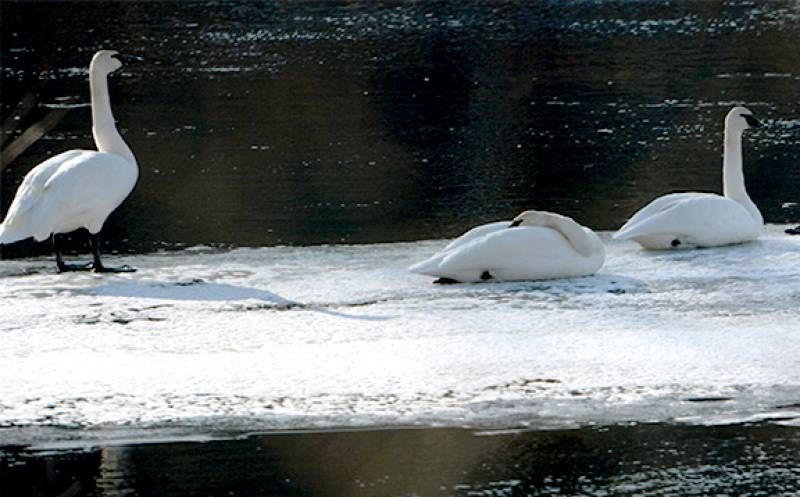Gray Merriam | Feb 26, 2020
Many folks in eastern Ontario have seen very huge white birds either flying or on the water. Those really huge white birds are Trumpeter Swans.
The last Trumpeter in Ontario was shot at Long Point in 1932. In 1988 Harry Lumsden, took on recovery of Trumpeters as a retirement project. You might have known Harry when he worked for Lands and Forests in Tweed.
Trumpeters were not wiped out in B.C. so 23 eggs were obtained and hatched in Ontario. Harry Lumsden found 23 volunteers who agreed to shelter and feed those hatchlings in eastern Ontario until they matured. From this effort 540 Trumpeters were released. The Ontario Trumpeter Swan Restoration Group was formed (www.trumpeterswansociety.org) and by 2010, there were about 1000 Trumpeters in the wilds of eastern Ontario. Some swans have nested and raised young. We commonly see the grayish young in late summer.
Trumpeter Swans are the largest swans in the world with wingspans reaching 8 feet. Trumpeters may be the heaviest bird capable of flight. They build huge nests, up to 3 metres across. Often they nest on top of old beaver lodges.
Trumpeter Swans do not migrate south. They flock in open water on the lower Great Lakes and on open rivers. On Lake Ontario they are in mixed flocks that include Tundra Swans and Mute Swans. Tundra Swans are native but nest only in the north. We see them as migrants. They are distinguished from the Trumpeters by a variable yellow patch between the bill and the eye and slightly smaller size. Mute Swans are invasive, non-natives that have escaped from swan flocks in urban areas that were imported from Europe. They have a red and black or yellow bill. They have bred widely and their population is increasing rapidly. They compete with Trumpeter Swans for nesting habitat.
Trumpeter Swans are grand birds to see, especially when they take off and spread those huge wings over you. They can be seen on the Salmon River and on McGowan's Lake. At summer's end, large numbers occur on the Crowe River near Marmora, on Consecon Lake in Prince Edward County, in Lake Ontario off Kingston and in lesser numbers in breeding habitat in the inland rivers and lakeland across eastern Ontario. Thanks to many volunteers and Harry Lumsden our swans are back as one of our most valuable natural riches.
More Stories
- No Winner Yet in Catch The Ace But Fundraising Target Met
- South Frontenac Food Bank Opens Second Location in Battersea
- Sharbot Lake Pentecostal Church Anniversary - 1925-2025
- Frontenac Holistic Health Fair - September 20 At Storrington Centre
- Odd Year For Real Estate - But Sales Are Steady Year Over Year
- 193rd Kingston Fall Fair
- Kim Phuc - the Napalm Girl - To Visit Flinton In November
- South Frontenac Council - September 2
- Sticker Shock - EV Charging Station To Cost North Frontenac Township
- 30th Anniversary Verona Car Show

